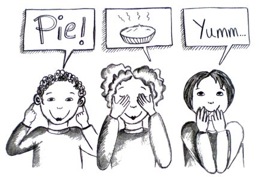A few weeks ago, I presented the dilemma of blogger Jared (Moon Over Martinborough), who recently began podcasts and was concerned that his oral delivery didn’t sound sufficiently “campfire-story”-esque.
I tossed around a few thoughts on achieving a natural-sounding delivery, including suggesting Jared not even read from his written text (did I really say that?). Jared’s dilemma affects many of us who want to deliver spoken content in a way that sounds natural and conversational but don’t want our words to sound read or memorized. Some people can speak wonderfully off-the-cuff, but Lord knows, I’m not one of them. We often depend on written text to help us feel confident in our delivery and ensure we don’t forget what we want to say. Look at President Obama, whose legendary dependence on teleprompters is so extreme that he uses them in classrooms of schoolchildren.
Thankfully, a wiser voice than mine has suggested that there’s no one way to master a story or other content. Karen Dietz, in an article called The Trick To Learning A Story, relates mastering a story to learning style, noting that techniques that work for one person may not work for another. “[S]ome people need to write it down,” Dietz writes, “but there are plenty of others who can simply visualize the story and follow the chain of images to tell it. Some people just need to repeatedly listen to a story to learn it. So it really depends on your learning style as to which method will work for you.”
Here’s Dietz’s discussion of learning styles and the technique that aligns with her styles and works for her:
[W]hen building your storytelling skills, you also need to determine your best method for learning and remembering your stories so you can easily recall and tell them.
What learning style are you — Kinesthetic (I have to do it and get the physical feel of it) or Auditory (I have to listen to it) or Visual (I have to see it)?
Most people are a combination of the three with one or two that are dominant. For me my strongest learning styles are Kinesthetic and Visual. If I can see the images in my minds eye, and then feel the images physically, then I’m half-way home.
My best method for learning stories is to think about the story I want to tell and how I want to tell it. Then I get out my 3×5 index cards and create a BRIO (brief reminder of image order), a technique I learned from storyteller Doug Lipman [www.storydynamics.com]. On each card I write a keyword of the image, or draw a stick figure/diagram/picture of it. No artistic talent is required. These are just my own scribbles. This is my visual learning style.
Then I go on a walk and start telling the story out loud. This is where I get to see if the order I THINK the images should go actually work out that way; 99% of the time they DO NOT, and as I walk I reorder them.
What I love about this method is that by walking and practicing out loud, I kinesthetically build the story into my body. I find I can recall that story when I need to, and tell it in ways that I know will get results. Once I get to this point, I’m then ready to practice telling the story with a listening partner.
Terrific advice. Adapt your story mastery to your learning style. Mine are auditory and visual — decidedly not kinesthetic. For me, I believe auditory dominates, so I’d like to develop a mastery technique that suits that style.
And while I’m praising Karen Dietz, I should point out that she has revamped her Web site and is offering excellent, free story-related tools here.
